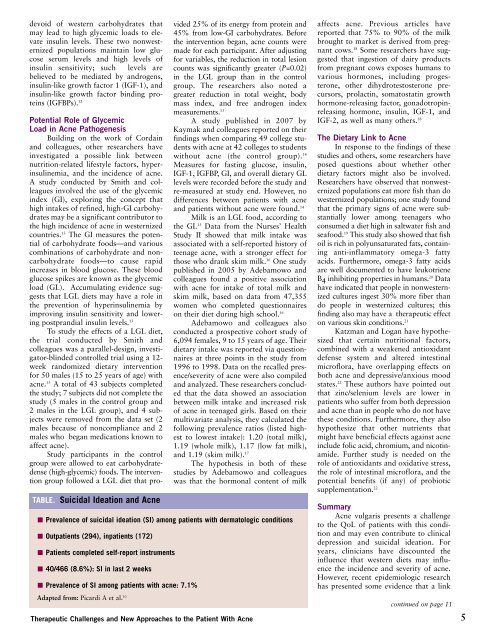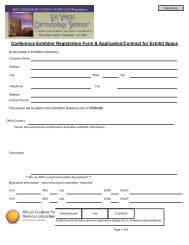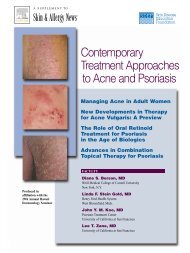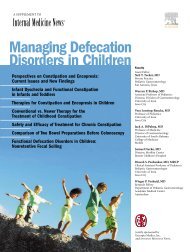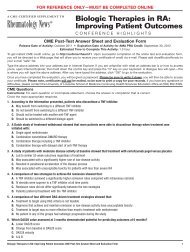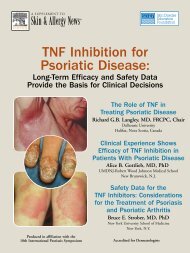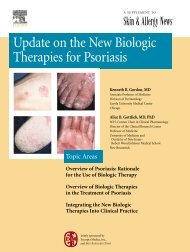Skin & Allergy News® - Global Academy for Medical Education
Skin & Allergy News® - Global Academy for Medical Education
Skin & Allergy News® - Global Academy for Medical Education
You also want an ePaper? Increase the reach of your titles
YUMPU automatically turns print PDFs into web optimized ePapers that Google loves.
devoid of western carbohydrates that<br />
may lead to high glycemic loads to elevate<br />
insulin levels. These two nonwesternized<br />
populations maintain low glucose<br />
serum levels and high levels of<br />
insulin sensitivity; such levels are<br />
believed to be mediated by androgens,<br />
insulin-like growth factor 1 (IGF-1), and<br />
insulin-like growth factor binding proteins<br />
(IGFBPs). 12<br />
TABLE. Suicidal Ideation and Acne<br />
Potential Role of Glycemic<br />
Load in Acne Pathogenesis<br />
Building on the work of Cordain<br />
and colleagues, other researchers have<br />
investigated a possible link between<br />
nutrition-related lifestyle factors, hyperinsulinemia,<br />
and the incidence of acne.<br />
A study conducted by Smith and colleagues<br />
involved the use of the glycemic<br />
index (GI), exploring the concept that<br />
high intakes of refined, high-GI carbohydrates<br />
may be a significant contributor to<br />
the high incidence of acne in westernized<br />
countries. 13 The GI measures the potential<br />
of carbohydrate foods—and various<br />
combinations of carbohydrate and noncarbohydrate<br />
foods—to cause rapid<br />
increases in blood glucose. These blood<br />
glucose spikes are known as the glycemic<br />
load (GL). Accumulating evidence suggests<br />
that LGL diets may have a role in<br />
the prevention of hyperinsulinemia by<br />
improving insulin sensitivity and lowering<br />
postprandial insulin levels. 13<br />
To study the effects of a LGL diet,<br />
the trial conducted by Smith and<br />
colleagues was a parallel-design, investigator-blinded<br />
controlled trial using a 12-<br />
week randomized dietary intervention<br />
<strong>for</strong> 50 males (15 to 25 years of age) with<br />
acne. 13 A total of 43 subjects completed<br />
the study; 7 subjects did not complete the<br />
study (5 males in the control group and<br />
2 males in the LGL group), and 4 subjects<br />
were removed from the data set (2<br />
males because of noncompliance and 2<br />
males who began medications known to<br />
affect acne).<br />
Study participants in the control<br />
group were allowed to eat carbohydratedense<br />
(high-glycemic) foods. The intervention<br />
group followed a LGL diet that provided<br />
25% of its energy from protein and<br />
45% from low-GI carbohydrates. Be<strong>for</strong>e<br />
the intervention began, acne counts were<br />
made <strong>for</strong> each participant. After adjusting<br />
<strong>for</strong> variables, the reduction in total lesion<br />
counts was significantly greater (P=0.02)<br />
in the LGL group than in the control<br />
group. The researchers also noted a<br />
greater reduction in total weight, body<br />
mass index, and free androgen index<br />
measurements. 13<br />
A study published in 2007 by<br />
Kaymak and colleagues reported on their<br />
findings when comparing 49 college students<br />
with acne at 42 colleges to students<br />
without acne (the control group). 14<br />
Measures <strong>for</strong> fasting glucose, insulin,<br />
IGF-1, IGFBP, GI, and overall dietary GL<br />
levels were recorded be<strong>for</strong>e the study and<br />
re-measured at study end. However, no<br />
differences between patients with acne<br />
and patients without acne were found. 14<br />
Milk is an LGL food, according to<br />
the GI. 15 Data from the Nurses’ Health<br />
Study II showed that milk intake was<br />
associated with a self-reported history of<br />
teenage acne, with a stronger effect <strong>for</strong><br />
those who drank skim milk. 16 One study<br />
published in 2005 by Adebamowo and<br />
colleagues found a positive association<br />
with acne <strong>for</strong> intake of total milk and<br />
skim milk, based on data from 47,355<br />
women who completed questionnaires<br />
on their diet during high school. 16<br />
Adebamowo and colleagues also<br />
conducted a prospective cohort study of<br />
6,094 females, 9 to 15 years of age. Their<br />
dietary intake was reported via questionnaires<br />
at three points in the study from<br />
1996 to 1998. Data on the recalled presence/severity<br />
of acne were also compiled<br />
and analyzed. These researchers concluded<br />
that the data showed an association<br />
between milk intake and increased risk<br />
of acne in teenaged girls. Based on their<br />
multivariate analysis, they calculated the<br />
following prevalence ratios (listed highest<br />
to lowest intake): 1.20 (total milk),<br />
1.19 (whole milk), 1.17 (low fat milk),<br />
and 1.19 (skim milk). 17<br />
The hypothesis in both of these<br />
studies by Adebamowo and colleagues<br />
was that the hormonal content of milk<br />
Prevalence of suicidal ideation (SI) among patients with dermatologic conditions<br />
Outpatients (294), inpatients (172)<br />
Patients completed self-report instruments<br />
40/466 (8.6%): SI in last 2 weeks<br />
Prevalence of SI among patients with acne: 7.1%<br />
affects acne. Previous articles have<br />
reported that 75% to 90% of the milk<br />
brought to market is derived from pregnant<br />
cows. 18 Some researchers have suggested<br />
that ingestion of dairy products<br />
from pregnant cows exposes humans to<br />
various hormones, including progesterone,<br />
other dihydrotestosterone precursors,<br />
prolactin, somatostatin growth<br />
hormone-releasing factor, gonadotropinreleasing<br />
hormone, insulin, IGF-1, and<br />
IGF-2, as well as many others. 18<br />
The Dietary Link to Acne<br />
In response to the findings of these<br />
studies and others, some researchers have<br />
posed questions about whether other<br />
dietary factors might also be involved.<br />
Researchers have observed that nonwesternized<br />
populations eat more fish than do<br />
westernized populations; one study found<br />
that the primary signs of acne were substantially<br />
lower among teenagers who<br />
consumed a diet high in saltwater fish and<br />
seafood. 19 This study also showed that fish<br />
oil is rich in polyunsaturated fats, containing<br />
anti-inflammatory omega-3 fatty<br />
acids. Furthermore, omega-3 fatty acids<br />
are well documented to have leukotriene<br />
B 4 inhibiting properties in humans. 20 Data<br />
have indicated that people in nonwesternized<br />
cultures ingest 30% more fiber than<br />
do people in westernized cultures; this<br />
finding also may have a therapeutic effect<br />
on various skin conditions. 21<br />
Katzman and Logan have hypothesized<br />
that certain nutritional factors,<br />
combined with a weakened antioxidant<br />
defense system and altered intestinal<br />
microflora, have overlapping effects on<br />
both acne and depressive/anxious mood<br />
states. 22 These authors have pointed out<br />
that zinc/selenium levels are lower in<br />
patients who suffer from both depression<br />
and acne than in people who do not have<br />
these conditions. Furthermore, they also<br />
hypothesize that other nutrients that<br />
might have beneficial effects against acne<br />
include folic acid, chromium, and nicotinamide.<br />
Further study is needed on the<br />
role of antioxidants and oxidative stress,<br />
the role of intestinal microflora, and the<br />
potential benefits (if any) of probiotic<br />
supplementation. 22<br />
Summary<br />
Acne vulgaris presents a challenge<br />
to the QoL of patients with this condition<br />
and may even contribute to clinical<br />
depression and suicidal ideation. For<br />
years, clinicians have discounted the<br />
influence that western diets may influence<br />
the incidence and severity of acne.<br />
However, recent epidemiologic research<br />
has presented some evidence that a link<br />
Adapted from: Picardi A et al. 10 continued on page 11<br />
Therapeutic Challenges and New Approaches to the Patient With Acne 5


